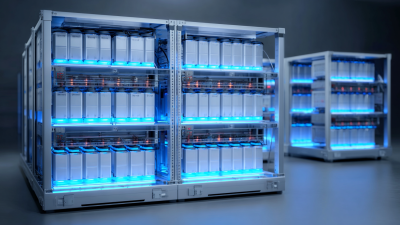The energy sector is undergoing a transformative shift propelled by advancements in power management systems, which are integral to optimizing energy consumption and enhancing efficiency. According to a report by the International Energy Agency (IEA), global electricity demand is projected to rise by 60% by 2040, making effective energy management more critical than ever. Innovative power management systems enable industries to harness real-time data, facilitating better decision-making and resource allocation. A study by McKinsey & Company reveals that implementing advanced power management solutions can lead to energy savings of up to 30% in industrial applications. With the increasing complexity of energy systems and the urgency to reduce carbon footprints, the adoption of digital and smart technologies in power management is essential for a sustainable energy future. As we delve into this topic, it becomes clear that the integration of innovative power management systems will be a cornerstone in shaping the future of energy.

In today's rapidly evolving energy landscape, the integration of digital technologies is transforming how we approach power management. From advanced data analytics to the Internet of Things (IoT), these innovations enable real-time monitoring and optimized energy distribution, facilitating a more efficient energy system. For instance, smart grids equipped with digital technologies can dynamically manage electricity flow, responding to fluctuations in demand and supply, ensuring that energy is utilized effectively.
 Tip: Implementing IoT devices can provide crucial insights into energy consumption patterns. Identify and monitor devices that consume the most energy, allowing for targeted interventions to enhance efficiency.
Tip: Implementing IoT devices can provide crucial insights into energy consumption patterns. Identify and monitor devices that consume the most energy, allowing for targeted interventions to enhance efficiency.
Moreover, predictive analytics in energy management allows companies to anticipate demand and prevent outages, which are crucial for maintaining reliable power supply. Digital solutions also play a significant role in integrating renewable energy sources, enabling users to harness solar and wind power more effectively. This not only supports sustainability goals but also aids in achieving cost savings.
Tip: Explore cloud-based platforms for managing energy resources. These platforms allow seamless integration of various energy systems, improving collaboration and decision-making across all stakeholders.
The integration of renewable energy sources with smart grid solutions is pivotal in addressing the growing energy demands and environmental challenges of our time. As the world shifts towards sustainable energy practices, the demand for advanced Energy Management Systems (EMS) is set to rise significantly. The EMS market is anticipated to expand rapidly, driven by innovations such as Home Energy Management Systems (HEMS) and other smart technologies. This growth underscores an increasing emphasis on optimizing energy consumption and enhancing grid reliability across various sectors.
The market for Battery Management Systems (BMS) reflects this trend, with projections indicating a significant increase from $11.42 billion in 2024 to $46.94 billion by 2032, showcasing a compound annual growth rate (CAGR) of 19.32%. Moreover, the digital energy consulting and management market is expected to grow from $1.08 billion in 2025 to $1.91 billion by 2034, at a CAGR of 6.5%. These developments are integral to the evolution of the smart grid, which stands as a cornerstone in revolutionizing the energy sector, fostering improved efficiency, and ensuring a sustainable future through innovative power management systems.
| Dimension | Description | Current Status | Future Prospects |
|---|---|---|---|
| Renewable Energy Sources | Types of renewable energy like solar, wind, and hydro | Increasing integration into the grid | Expected to contribute 50% of energy mix by 2030 |
| Smart Grid Technology | Uses digital communication to improve the electricity distribution | Gradual implementation in urban areas | Projected to enhance efficiency and reliability by 70% |
| Energy Storage Solutions | Batteries and other systems that store energy for later use | Growing market but still limited capacity | Advancements expected to triple capacity in next 5 years |
| Demand Response Programs | Programs to adjust the demand for power instead of supply | Adoption is increasing but not widespread | Anticipated to mitigate peak load by 30% by 2025 |
| Energy Efficiency Initiatives | Programs aimed at reducing energy consumption | Many initiatives are in place, with varying success | Predicted to lower consumption by 15% by 2030 |
Artificial Intelligence (AI) and machine learning are playing a pivotal role in revolutionizing energy distribution, particularly in managing and maintaining power grids. By leveraging advanced algorithms and data analytics, power companies can predict maintenance needs, optimize asset performance, and enhance operational efficiency. This proactive approach not only reduces downtime but also minimizes costs associated with traditional maintenance strategies. As the energy landscape shifts towards a more sustainable future, AI-driven solutions are becoming indispensable in ensuring that energy distribution networks operate smoothly and reliably.
The potential of AI in the energy sector is evident, with market projections indicating significant growth, expected to reach USD 58.66 billion by 2030. One of the most innovative applications is in smart grid technology, where real-time data integration allows for dynamic decision-making. AI algorithms can analyze vast amounts of data generated by energy consumption patterns, enabling utilities to balance supply and demand efficiently. Additionally, advancements like AI-powered mobile mapping are transforming utility asset management, allowing for precise monitoring and maintenance of infrastructure. This technological evolution is setting the stage for a more resilient and responsive energy system.
This chart illustrates the distribution of energy sources utilized in 2023, highlighting the transition towards renewable energy and the significant role of AI and machine learning in optimizing power management systems.
In today’s rapidly evolving energy landscape, real-time data analytics has emerged as a pivotal tool for optimizing energy consumption. By harnessing vast amounts of data generated from various sources, organizations can gain immediate insights into their energy usage patterns and identify inefficiencies. These analytics enable energy managers to make informed decisions, adjust energy consumption in real-time, and ultimately reduce costs while maintaining operational efficiency.

Moreover, innovative power management systems equipped with advanced analytics can anticipate energy demands and dynamically adjust supply accordingly. This not only enhances the reliability of energy distribution but also supports the integration of renewable energy sources into the grid. By analyzing data from smart meters and IoT devices, these systems can facilitate demand response strategies, enabling consumers to shift their energy usage to lower-cost time periods. This proactive approach not only optimizes individual energy consumption but also contributes to a more sustainable and resilient energy infrastructure.
The future of energy management systems (EMS) is poised to undergo significant transformation as sustainability becomes a central focus. The integration of renewable energy sources, such as solar and wind power, necessitates advanced EMS that can optimize energy consumption and reduce waste. Innovations in smart grid technology will enable real-time data analysis, allowing for automated adjustments to energy distribution based on demand and supply variations. This shift towards a more responsive infrastructure will play a crucial role in achieving sustainable development goals by minimizing carbon footprints and enhancing energy efficiency.
Furthermore, the proliferation of Internet of Things (IoT) devices is set to revolutionize energy management practices. By connecting various elements within energy ecosystems, such as buildings, industrial facilities, and electric vehicles, EMS can leverage data-driven insights for improved performance. Predictive analytics can forecast energy usage patterns, allowing organizations to proactively manage resources and reduce peak loads. As we move towards a decentralized energy model, characterized by local energy generation and consumption, effective EMS will be essential for optimizing both economic and environmental outcomes, ultimately supporting a sustainable future for all.





